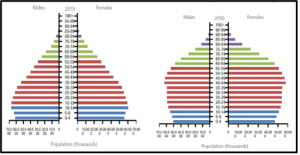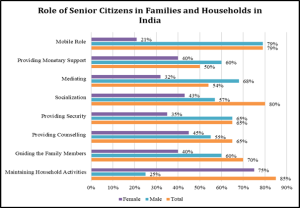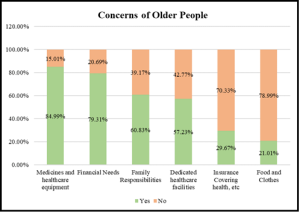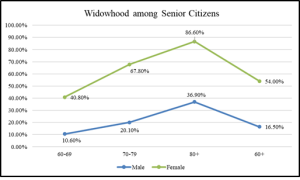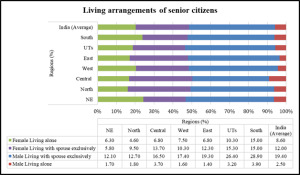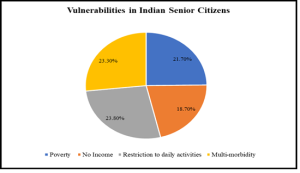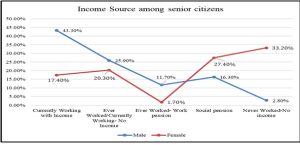The Problems and Prospects of Senior Citizens of India
- Mr. Suresh Kashinath Ghatge
- Prof.(Dr.) Anuradha Parasar
- -444
- May 10, 2024
- Business Management
The Problems and Prospects of Senior Citizens of India
Mr. Suresh Kashinath Ghatge1, Prof.(Dr.) Anuradha Parasar2
1Ph.D. Research Scholar, Liberal Education(Sociology), Galgotias University,Greater Noida,Uttar Pradesh(India)
2Professor of Liberal Education Galgotia University, Greater Noida, Uttar Pradesh, India.
DOI: https://doi.org/10.51244/IJRSI.2024.1104032
Received: 27 March 2024; Revised: 09 April 2024; Accepted: 13 April 2024; Published: 10 May 2024
ABSTRACT
The primary focus of this article is on the problems and prospects of senior citizens in India. The term senior citizens refers to individuals who are above 60 years of age and below 80, with population above 80 years being referred as super senior citizens. It is noted that the number of senior citizens has increased significantly in India and is expected to rise further in the upcoming years. Hence, investigating the problems and prospects of the lives of senior citizens is highly important for ensuring stability and dignity to their ageing process. This article has considered gathering relevant statistical quantitative data from secondary sources such as previous studies, peer-reviewed journals, various state, central government reports and international institution reports, newspaper articles and others. The gathered secondary quantitative data has been analysed with the help of thematic analysis for elaborating the objective information in relation to the objectives this study intends to explore. The results show that the overall life quality and condition of living of the senior citizens of India is considerably good except for the population living in poverty. Various government welfare schemes and programs assist senior citizens and help improve the quality of life and living standards.
Keywords: Senior citizens, Super senior citizens, Government schemes, Initiatives, Population, Standard of living
INTRODUCTION
Senior citizens represent a major fragment of the overall Indian population and their influence on the society is crucial for stable social development. Over 14.9 crore people were reported in 2022 to be of the ages 60 and above, constituting over 10.5% of the population, with an estimation of increasing to 15% by the year 2036 (Pandit, 2023). Recognising and evaluating the problems and prospects of senior citizens of India is highly relevant to ascertaining the issues and prospective developments for dignified ageing and stability of Indian senior citizens. This article considers exploring the evolving challenges faced by senior citizens in India and appraises the potential for the ageing population in Indian society. Moreover, the study studies the function of senior citizens in paving the way for stable social development and the necessity for providing a safe and secure environment for such a population to ensure ageing with dignity.
The various ministries and government offices in India usually deal with matters regarding senior citizens and their livelihoods and circumstances. As per the Indian government’s definition, any person above the age of 60 years and below 80 years is considered to be a senior citizen in India (Incometax.gov.in, 2024). The population above 80 years of age can be termed as a “super senior citizen”. It is noted that the elderly population possesses a great deal of knowledge from their professional and personal experiences and therefore can contribute to the wholesome development of society. Hence, these individuals need to be taken care of to make sure that Indian society grows towards the right direction. Several governmental initiatives are aimed at providing a good standard of living for the senior citizens of India. These initiatives ensure that the older population can live comfortably and access necessary assistance whenever needed.
Figure 1: Population distribution of 2019 and expected change in 2050 in India
(Source: Sahoo et al. 2023)
Governmental organisations and ministries develop and implement various schemes for the welfare of senior citizens. The share of elderly population in India has increased and within the past decades due to several underlying factors including healthcare, life expectancy, and overall education among the population. The senior citizen population had grown with an increase of 60-year-old people from 5.3% in 1971 to 8% in 2019 and the population rate of over 80-year-old citizens increasing from doubled from 0.4% in 1950 to 0.94% in 2015, with expectancy of rise in senior citizen population to 48 million, over 3% of total Indian population by 2050 (Sahoo et al. 2023). Since a great deal of the population comes under the category of senior citizens, addressing their problems and prospects of life has become highly necessary.
Hence, the above overview of observations brings us to exploring the following objectives regarding the challenges and probabilities for Indian senior citizens for ageing with dignity, noting the rapid growth in the older population. The study shares the following objectives.
- To explore the circumstantial conditions of senior citizens in India.
- To identify the diverse influences and concerns that the senior citizens in Indian society have in terms of living and ageing with dignity.
- To investigate the challenges and prospects that are associated with different vulnerabilities among senior citizens in India.
- To explore the significance of different prospective actions optimistic for senior citizens ageing with dignity.
METHODS
This article considers implementing a secondary quantitative research to explore the study in the perspective of problems and prospects for senior citizens in India. The study would be applying secondary data collection methods for the accumulation of quantitative and statistical information concerning an objective development of the study. Required secondary sources include such as books, data sheets, peer-reviewed journals, previous research on the same or similar topics, official publications and reports from central and state governments and others (Pandey and Pandey, 2021). This study has considered gathering secondary, subjective and statistical data from sources such as state and central government reports, journals, and newspaper reports from “Times of India”, “Hindustan Times”, “The Hindu” and others as well as previous studies.
The use of published and publicly accessible articles is capable of significantly augmenting to the authenticity and consistency of the results of this paper. Studies suggest that thematic analysis is the most suitable way to analyse secondary data and could be applicable for elaborating on quantitative information through textual and conceptual explanations (Robinson, 2022). Furthermore, these quantitative and factual secondary data have been analysed with the help of thematic analysis based on certain relevant themes that have been developed in the results section of the study.
RESULTS
Inspecting the role of senior citizens for enhancing stability in Indian society
Figure 2: Role of Senior Citizens in Families and Households in India
(Source: Developed based on Ayoob, 2020)
Senior citizens teach the younger generations about the traditions and cultural values of society and even help them develop a strong sense of moral values. The census data of 2011 show that almost 8.6% of the total Indian population is above 60 years of age (PIB.gov.in, 2018). It is further noted that the role of the elderly population in the household is considerably high in Indian society as well. As per the above data, the relevance of the elderly population in terms of guiding family members, maintaining the household, providing security and counselling, and mediating is significantly high though there are differences among the male and female senior citizens. On an average, 85% of senior citizens participate in maintaining household activities, 70% and 65% of the elderly provide guidance and counselling to family respectively (Ayoob, 2020). It can be thus inferred that senior citizens perform the above-mentioned roles and help maintain stability in individual households and overall society.
It is noted that the senior citizens in India as a particularly ageing segment of diverse populations show strong dependence for emotional and financial support on the younger generation. According to Ayoob (2020), only 50% of senior citizens are capable of the role for contributing through providing monetary support, with a difference among male and female seniors, with 60% male elderly and 40% female senior citizens able to do so. The responsibilites of the elderly population are essentially fundamental this population group are conscious keepers of cultural and traditional values in any society. In the address of the Vice President, the word “old” replaced with “senior” emphasised the salute towards senior citizens’ wisdom while addressing the general population has mentioned the need for extending all facilities for the senior population to increase ease in their lives (PIB.gov.in, 2018). It becomes the responsibility of every individual, therefore, to respect such individuals and develop a societal and economic system that is efficient in caring for these individuals and providing necessary assistance.
Studies demonstrate that the roles and responsibilities of senior citizens regarding, societal and civic matters are exceedingly noteworthy. Over 80% of senior citizens have an significant influence on the activities of socialisations among the family members in Indian society (Ayoob, 2020). Senior citizens take part in “civic society organisations” and also contribute towards co-decisional and consultative participatory initiatives (Falanga et al. 2021). The political and social activities of senior citizens are highly significant in ensuring stability in society and social organisations. Therefore, relevant welfare measures must be taken to support the senior citizens.
Analysing the present conditions and circumstances of Senior citizens of India
Figure 3: Growing concerns for the elderly population in India
(Source: Developed based on Social.un.org, 2020)
As per the above data, the requirement for financial needs and assistance, food, clothes and shelter has increased. Over 84.99% elderly showed concerns regarding availability of medicine and healthcare equipment, and 57.23% public responded their concerns regarding access to better healthcare facilities (Social.un.org, 2020). Since the trend of overly nuclearised families particularly in urban settings have increased, the realisation of accessibility to essential supplies and support have also grown rapidly.
It is noted that the financial conditions of the elderly population can be directly associated with the overall financial independence of such a population. Over 79.31% of the senior population express concerns regarding financial needs (Social.un.org, 2020). Additionally, other government reports show a majority of the older population in India struggle financially with low savings problems. It has been noted that the ageing population of India is highly ruralised and feminised and therefore, the government need to develop policies based on these trends to make sure that the specific needs of such ruralised elderly population can be effectively addressed (Thehindu.com, 2023). Additionally, a gap between the younger generation and the older population has developed due to the younger population being highly motivated to realise their full academic or career potential. Reports show that 1 in every 5 elderly individuals is suffering from mental health issues that developed due to loneliness (Shiraz, 2023). This increased loneliness and a lack of familial support among the elderly population in India. Hence, societal support needs to be provided to such a population to help them deal better with such issues.
India is a country with a diverse population and the number of the older population among these diverse types of population has been increasing. On the other hand, the society of India has multiple crippling issues such as illiteracy, poverty and others that negatively impact the lives of the older population as well. Studies show that more than 25% of the population in urban India lives in poverty which further suggests that nearly 8 crore population live below the poverty level (Alok, 2020). This affects the quality of life of the older population as well. Correspondingly, around 21.01% of the elderly population present concerns regarding food, clothing and shelter (Social.un.org, 2020). It is noted that poverty prevalent among the older population can be considered inherently gendered as older widowed women are considerably more likely to live alone and without any stable financial support. These women are more likely to be impacted by some form of morbidities that restricts their functionality. Hence, they become completely dependent on family or external support.
Since 1991, the sex ratio among elderly population has become disproportionate and the number of elderly women has experienced a stark rise. Further, the studies by “Agewell Helplines” imply the fact that only less than 20% of women senior citizens and the majority of male senior citizens are economically well off (Social.un.org, 2020). Usually, senior citizens who experience financial hardships belong to the lower, lower-middle or middle classes. Most of such senior citizens depend on relatives, children or others. A great amount of data as per the mentioned studies from all over India depicts that nearly 65% of senior citizens are dependent on other individuals for day-to-day activities and maintenance (Social.un.org, 2020). Additionally, 60.83% of the elderly population have concerns for maintaining family responsibilities. All such factors are indicative of the fact that the older population in India are negatively impacted by various social as well as economic factors and requires necessary assistance to lead a life with dignity.
Evaluating the relevance of ensuring ageing with dignity for Senior citizens of India
Figure 4: Widowhood among senior Citizens
(Source: Developed based on Unfpa.org, 2023)
Reports show that in India, older women have a higher life expectancy compared to their male counterparts and therefore, their being widowed is quite common. Among widowed senior citizens above 60 years, over 54.00% of the widowed elderly population are females, compared to 16.50% of the male senior citizens, and over 84.60% of widowed elderly above 80 years of age are widowed women, while around 36.90% of same population are male (Unfpa.org, 2023). The share of widowhood could be observed as a comparative demographic life expectancy among male and female senior citizens. In addition, almost 60% of elderly women in India are widowed and require social and financial support to lead a life with dignity (Srivastava et al. 2021). Cooperative actions among these ministries can better address the social, financial and other issues with ageing. A specific focus on the elderly women population while developing welfare schemes for the elderly would potentially improve the overall condition of senior citizens in India.
Figure 5: Living arrangements of senior citizens in India, region wise
(Source: Developed based on Unfpa.org, 2023)
Aging with dignity refers to the availability of lifestyle choices among individuals that enable them to lead a quality life fulfilling all basic needs effectively and without much struggle. Demographic distribution of Indian senior citizens regarding living arrangements of the elderly population that are not living with their adult offsprings are insightful for an idea on dignified ageing. According to recent studies, 8.60% of female senior citizens and 2.50% of male senior citizens live alone, while 12 of female elderly and 19.40% of the male elderly population live exclusively with their spouse (Unfpa.org, 2023). Integration of the notion of dignity in the overall care system of older people is highly important.
This population has a greater scope of developing interdependent and multiple vulnerabilities with age such as cognitive, psychological, physical and social. The entire concept regarding dignity is highly complex as it considers the ethical and moral basis for improving the scope for “quality of life” and “sense of well-being” among individuals (Banerjee et al. 2021). In this regard ensuring social contact and interaction with other similar individuals and even the younger population is highly significant to make sure that the older individuals live a dignified and healthy life.
Examining the problems faced by senior citizens of India on a regular basis
Figure 6: Vulnerabilities among Indian senior citizens
(Source: Developed Based on Unfpa.org, 2023)
There are primarily various problems that an average senior citizen in India faces. As per the government reports and data, there are various types of problems such as social, financial and health-related issues that can be generally associated with old age. Over 18.70% of the senior citizen population are reportedly without any income in India (Unfpa.org, 2023). It is noted that a lot of the senior citizens in India live in poverty 21.70% living in poverty as of 2017-18 (Unfpa.org, 2023). As per a report published by the United Nations among the older population in India more than 40% live in poverty and have the “poorest wealth quintile” and almost about 18.7% of the older population has no sustainable source of income as well (Timesofindia. indiatimes.com, 2023). Since such a great number of the elderly population in India are living in poverty, government policies and schemes need to develop measures for alleviation of the poor section of the older population.
Senior citizens face severe challenges regarding health conditions and healthcare needs. The “Ministry of Health and Family Welfare” has developed the “National Programme for Health Care of the Elderly” to address healthcare needs and issues faced by the elderly population comprehensively (MOHFW.gov.in, 2022). Over 23.30% of senior citizens are reportedly suffering from multiple morbidities and more than 23.80% of the elderly population suffer from challenges restricting daily activities (Unfpa.org, 2023). Development of multiple disabilities, health issues such as deafness, blindness, and locomotor disability along with mental illness is quite common among senior citizens. These are some of the most significant challenges faced by senior citizens on a day-to-day basis in India.
Among the social problems that the older population faces one of the most significant ones is the negligence of adult individuals towards their old parents. Additionally, senior citizens in India often go through “disillusionment due to retirement”, powerlessness and helplessness (Loksabhadocs.nic.in, 2020). Developing a feeling of loneliness and social isolation is quite common among the older population as well. All such factors have a significant negative impact on the mental health and lifestyle of the senior citizens. In this regard, it can be further mentioned that ageing with dignity can be severely compromised when these issues are not addressed properly.
Analysing the Prospects for Senior Citizens in Indian Society
Figure 7: Distribution of different financial sources among senior citizens
(Source: Developed Based on Unfpa.org, 2023)
Ageing is a natural process that is associated with time deterioration of both psychological and physical functioning. Financial capacity and scope of income sources are associated with the abilities of the senior citizens to be able to support their physical, psychological and essential needs and functioning. Over 33.20% of female senior citizens against 2.40% of male senior citizens had never worked and are without income sources (Unfpa.org, 2023). There is a sharp necessity for welfare policies to be focused on empowering senior citizens to assist them in living and ageing with dignity particularly for the women elderly population.
There are various government initiatives, schemes and programs to enhance the prospects of senior citizens of India. The Indian government has launched the “Pradhan Mantri Vaya Vandana Yojana” scheme for senior citizens over 60 years of age are assured a return of 8% interest per annum for 10 years (Online Yojana Team, 2019). There are yearly, quarterly or monthly payment systems for the pensioners in this scheme. The Indian government has identified the top four needs of the senior citizens such as food, financial security, human interaction for a dignified life and necessary healthcare and based on these aspects have developed necessary schemes to support the senior citizens (PIB.gov.in, 2022). In this regard “Atal Vayo Abhyudaya Yojana” (AVYAY) was implemented in 2021 which is an umbrella scheme that helps tackle the challenges faced by senior citizens.
Healthcare services are another important aspect in India for the elderly people. The national program for the healthcare of the elderly has been established to offer promotive healthcare services. Senior citizens of India can access healthcare services easily through these schemes to live a healthy and prosperous life. The “Scheme of Integrated Programme for Senior Citizens” (IPSrC) is focused on developing homes for senior citizens, especially for indigent ones to provide basic amenities such as medical care, food, and shelter to such citizens (PIB.gov.in, 2022). “Livelihood and Skilling Initiatives for Senior Citizens” aims at providing necessary skills to senior citizens to increase the prospect of re-employment opportunities. This enhances financial stability and prospects for senior citizens in India.
The cost of healthcare services has increased globally in the past decades. Senior citizens who have suffered from several kinds of diseases need continuous medication facilities for living. The Indian government offers a “Varistha Mediclaim Policy” that helps senior citizens between 60 to 80 years of age in the country by covering most of their medical-related expenses (GIBL.in, 2020). The policy can be customized for individual citizens to offer them various facilities such as medicine costs, ambulance services and blood transfusions. This policy has been offered to cover the cost related to inpatient treatment such as ayurveda, allopathy and homoeopathy. The pre-hospitalisation and post-hospitalisation costs of elderly citizens have been paid by the government under this scheme. Therefore, the Indian government has prioritized the necessity of healthcare and support for the elderly citizens of the country.
DISCUSSION
The term ageing has grabbed the attention of policymakers, development agencies and many non-government organizations. Ageing can be defined as the capability of living in a house of his/her choice independently or independently. The phenomena of the process of ageing cannot be stopped or reversed. With ageing, numerous challenges have arisen in the lives of elderly citizens of the country. There have been a lot of initiatives taken by governments all over the world to develop a more inclusive environment for senior citizens. Senior citizens can help the young generations in every aspect of their lives with the experiences they have gained in their lifetime.
It is not only the responsibility of the government of the country but also the younger generation should take the responsibility of taking care of the senior people surrounding them. The number of senior citizens who are above 60 years of age is increasing rapidly globally with a disproportionate population distribution among male and female senior citizens. The number is also growing in India at a fast pace. In India, most of the children along with their spouse lived with their parents after their marriage. The relevance of senior populations in Indian society can be considered significantly high compared to other communities.
In India, senior citizens are considered as the flag bearers belonging to various diverse groups. Most of the senior people have a higher dependence on the younger generation. Indian culture teaches the younger generation to respect and support the senior citizens in society even if the senior citizen is unknown. There is a need for teaching moral values to the younger generations of the country that can increase the significance of the elderly people in society overall. Senior citizens have an integral impact in terms of dignified ageing with their motivational participation in several political and socio-cultural activities mainly due to their pronounced influence on socialisation activities within households and families. This can ensure more stability in the community in India. The quality of the elderly population who are living under the extreme poverty line is terrible. The elderly widowed women are more likely to live longer than the elderly men in the last stage of their lives, alongside the fact that a large section of elderly women live alone than men. These senior woman citizens are more prone to some form of morbidities that decrease their ability to function regularly. Therefore, senior women citizens are most likely to remain under the observance of their families and depend fully on them.
Various social and economic factors have negatively impacted the gender ratio of the elderly population in India. The number of elderly women has risen in the last few decades in India. The majority of the Indian elderly women population have been struggling financially after their husbands’ death or due to divorce at a later stage of their married life. On the other hand, the majority of male senior citizens are living an economically sound life after the death of their spouse. Most of the senior women citizens are dependent on their relatives, children or other old aged homes. With the growing population, the need for fundamental resources, shelter and healthcare has increased sharply for the elderly population In India.
CONCLUSION
The senior population of a country is considered a great aspect of a country’s growth. Various social and economic factors have influenced the lifestyle of the elderly population of India. The trend of nuclear families has increased over the past few decades in Indian society. The senior citizens are getting more independent in their family. Senior citizens prefer ageing with dignity with accessibility to essential resources such as financial support, shelter, food, medical facilities, and entertainment. Several policies have been launched by the Indian government to provide basic facilities to all senior citizens and have benefited the elderly people in leading a better life. Active participation in various political and cultural activities has made the elderly people realize their value in society. The younger generation should take the guidance of the elderly people belonging to their families and society can help them in achieving their life goals more effectively. The gender ratio of the elderly population is a growing challenge for the government that can be solved by providing economic support, especially for the woman population. The economic situation of the elderly people can be positively influenced by the economic boost of the country.
REFERENCES
- Alok, A., (2020). Problem of poverty in India. International Journal of Research and Review, 7(1), 174-181.
- Ayoob, S. M., (2020). Senior Citizens and Their Roles in Family and Household, Journal of Politics and Law; Vol. 13, No. 2, 32-43.
- Banerjee, D., Rabheru, K. and Ivbijaro, G., (2021). Dignity of older persons with mental health conditions: Why should clinicians care?. Frontiers in Psychiatry, 12, 774533.
- Falanga, R., Cebulla, A., Principi, A. and Socci, M., (2021). The participation of senior citizens in policy-making: patterning initiatives in Europe. International journal of environmental research and public health, 18(1), 34.
- GIBL.in, (2020), National Senior Citizen Mediclaim Policy in Just 2 Minutes, Retrieved on 2nd March 2024, from: https://www.gibl.in/national-insurance/national-varistha-mediclaim-policy/
- Incometax.gov.in, (2024). Senior Citizens and Super Senior Citizens for AY 2023-2024. Retrieved on: 5 March, 2024 from: https://www.incometax.gov.in/iec/foportal/help/individual/return-applicable-2#:~:text=An%20individual%20resident%20who%20is,time%20during%20the%20previous%20year.
- Loksabhadocs.nic.in, (2020). SENIOR CITIZENS – THEIR NEEDS AND OUR PRIORITIES. Retrieved on: 5 March, 2024 from: https://loksabhadocs.nic.in/Refinput/New Reference Notes/English/06072020 122044 1021205239.pdf
- MOHFW.gov.in, (2022). NATIONAL PROGRAMME FOR HEALTH CARE OF THE ELDERLY(NPHCE) Retrieved on: 5 March, 2024 from: https://main.mohfw.gov.in/?q=major-programmes/Non-Communicable-Diseases/Non-Communicable-Diseases-1
- Online Yojana Team, (2019), Pradhan Mantri Vaya Vandana Yojana (PMVVY) Details, Retrieved on 2nd March 2024, from: https://onlineyojana.in/pradhan-mantri-vaya-vandana-yojana-pmvvy-details/
- Pandey, P. and Pandey, M.M., (2021). Research methodology tools and techniques. Bridge Center, 1-118.
- Pandit, A. (2023). India aging rapidly, 60+ will make up 15% of population by 2036: UN. Retrieved on 28th March 2024, from: https://timesofindia.indiatimes.com/india/india-aging-rapidly-60-will-make-up-15-of-population-by-2036-un/articleshow/104001546.cms
- PIB.gov.in, (2018). Elderly people are the conscious keepers of our society and it is everybody’s responsibility to respect them: Vice President. Retrieved on: 5 March, 2024 from: https://pib.gov.in/newsite/PrintRelease.aspx?relid=183868#:~:text=Every%20society%20has%20age%20old,honour%20and%20samskar%20and%20wisdom.
- PIB.gov.in, (2022). Schemes for The Welfare of Senior Citizens Retrieved on: 5 March, 2024 from: https://pib.gov.in/PressReleasePage.aspx?PRID=1806506
- Robinson, O. C. (2022). Conducting thematic analysis on brief texts: The structured tabular approach. Qualitative Psychology, 9(2), 194.
- Sahoo, P.M., Rout, H.S. and Jakovljevic, M., (2023). Consequences of India’s population aging to its healthcare financing and provision. Journal of Medical Economics, 26(1), 308-315.
- Shiraz, Z., (2023). Strategies to combat the impact of loneliness on the mental health of elderly. Retrieved on: 5 March, 2024 from: https://www.hindustantimes.com/lifestyle/relationships/strategies-to-combat-the-impact-of-loneliness-on-the-mental-health-of-elderly-101691743374625.html
- Social.un.org, (2020). FINANCIAL STATUS OF OLDER PEOPLE IN INDIA – An ASSESSMENT. Retrieved on: 5 March, 2024 from: https://social.un.org/ageing-working-group/documents/seventh/AgewellFoundationSubmission.pdf
- Srivastava, S., Debnath, P., Shri, N. and Muhammad, T., (2021). The association of widowhood and living alone with depression among older adults in India. Scientific reports, 11(1), 21641.
- Thehindu.com, (2023). India ageing, elderly to make up 20% of population by 2050: UNFPA report. Retrieved on: 5 March, 2024 from: https://www.thehindu.com/sci-tech/health/share-of-elderly-projected-to-double-to-20-by-2050-india-ageing-report/article67353547.ece
- Timesofindia.indiatimes.com, (2023). More than 40% of elderly in India in poorest wealth quantile: UN report. Retrieved on: 5 March, 2024 from: https://timesofindia.indiatimes.com/india/more-than-40-of-elderly-in-india-in-poorest-wealth-quintile-un-report/articleshow/103995308.cms
- Unfpa.org. (2023). Economic Status. .Institutional Responses – INDIA AGEING REPORT 2023. Retrieved on 28th March 2024, from: https://india.unfpa.org/sites/default/files/pub-pdf/20230926 india ageing report 2023 web version.pdf#page=55&zoom=100,0,0
- Unfpa.org. (2023). Socio-Demographic Status of the Older Population. .Institutional Responses – INDIA AGEING REPORT 2023. Retrieved on 28th March 2024, from: https://india.unfpa.org/sites/default/files/pub-pdf/20230926 india ageing report 2023 web version.pdf#page=51&zoom=100,0,0
- Unfpa.org. (2023). Vulnerability among Older Population. .Institutional Responses – INDIA AGEING REPORT 2023. Retrieved on 28th March 2024, from: https://india.unfpa.org/sites/default/files/pub-pdf/20230926 india ageing report 2023 web version.pdf#page=65&zoom=100,0,0


